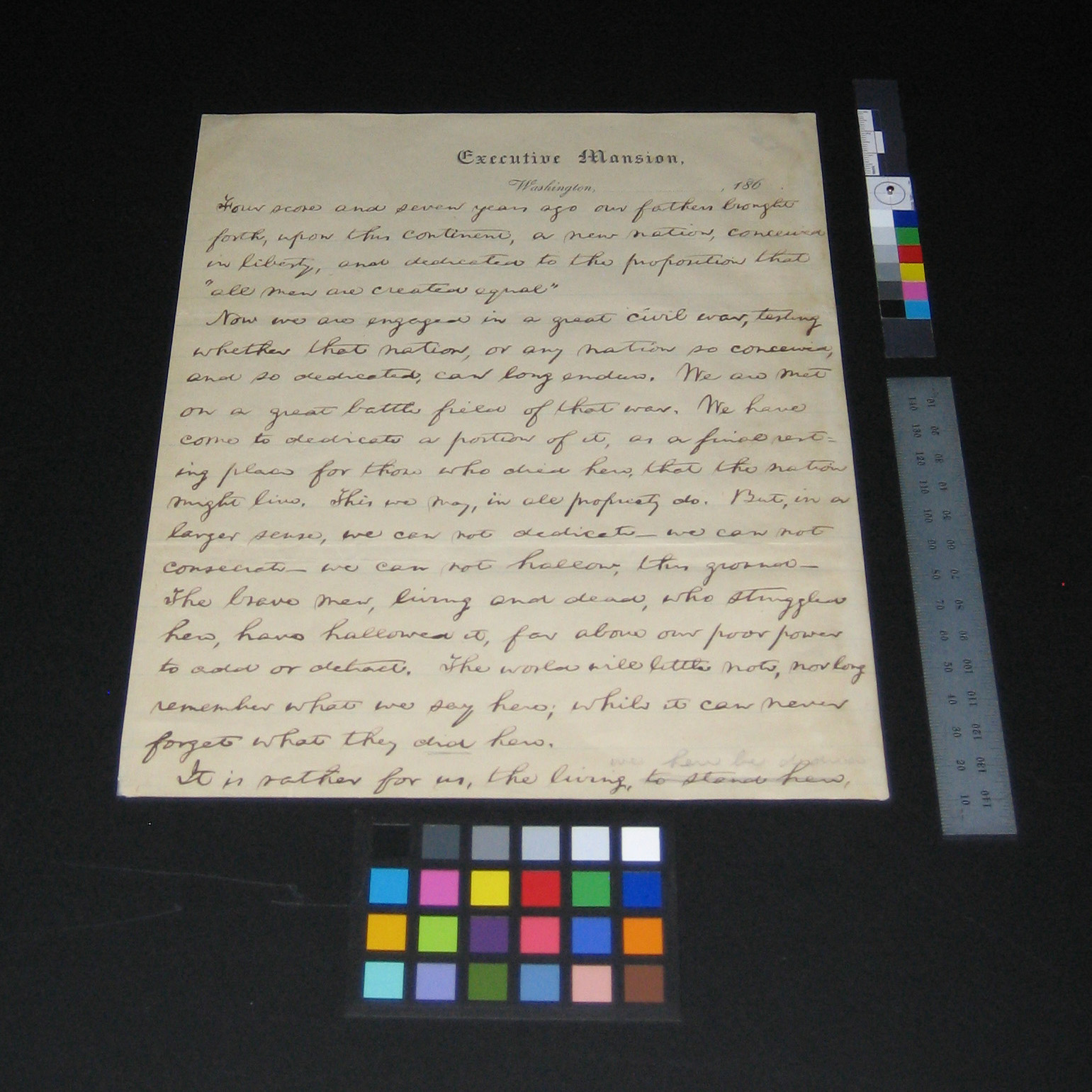An Introduction to Spectral Imaging
Cite page (MLA): Wisnicki, Adrian S., and Heather F. Ball. "Introduction to Spectral Imaging." In Livingstone's Letter from Bambarre. Adrian S. Wisnicki, dir. Livingstone Online. Adrian S. Wisnicki and Megan Ward, dirs. University of Maryland Libraries, 2017. Web. http://livingstoneonline.org/uuid/node/6b92625f-5f97-46c4-845c-54a9516137ca.
This page provides a brief introduction to the spectral imaging process and describes how a number of previous spectral imaging projects set the stage for the imaging and analysis of Livingstone's Letter from Bambarre.
Spectral imaging, a digital imaging technique with a variety of applications, is used in cultural heritage studies to enhance select components of a document or object. The object is illuminated by a number of narrow bands of wavelengths of light from the ultraviolet (UV) through the visible and the infrared (IR) spectrum. An image is taken of the object when exposed to each wavelength, with the resulting series of images stacked together to form a spectral map of the imaged object. Working with this image stack, imaging scientists then write mathematical algorithms to highlight and analyze specific components of the given document.
![The first page of the Letter from Bambarre (Livingstone 1871c:[1]) as illuminated by twelve wavelenghts of light, ranging from the ultraviolet (365nm), upper left corner, to the near infrared (870nm), lower right corer. Copyright Peter and Nejma Beard. Creative Commons Attribution-NonCommercial 3.0 Unported (https://creativecommons.org/licenses/by-nc/3.0/). The first page of the Letter from Bambarre (Livingstone 1871c:[1]) as illuminated by twelve wavelenghts of light, ranging from the ultraviolet (365nm), upper left corner, to the near infrared (870nm), lower right corer. Copyright Peter and Nejma Beard. Creative Commons Attribution-NonCommercial 3.0 Unported (https://creativecommons.org/licenses/by-nc/3.0/).](/sites/default/files/spectral-imaging/introduction-spectral-imaging/12-wavelengths-1200.jpg)
The first page of the Letter from Bambarre (Livingstone 1871c:[1]) as illuminated by twelve wavelenghts of light, ranging from the ultraviolet (365nm), upper left corner, to the near infrared (870nm), lower right corer. Copyright Peter and Nejma Beard. Creative Commons Attribution-NonCommercial 3.0 Unported
There are two levels of spectral imaging: hyperspectral and multispectral. With hyperspectral imaging, an object is exposed to a broad range of very narrow wavelengths across the UV, visible and IR portions of the electromagnetic spectrum. Multispectral imaging (the technique applied to Livingstone’s letter) only exposes the object to a set of predetermined wavelengths in this portion of the spectrum.
Although first pioneered by NASA for studying the solar system, spectral imaging has since been used in a variety of contexts, from satellite imaging and forensics to biology, and national security studies. In 1993 the Dead Sea Scrolls became among the first manuscripts to be studied with spectral imaging. By imaging the scrolls with infrared film, researchers tried to recover faded or illegible text and passages.

A processed spectral image of a folio of the Archimedes Palimpsest. Copyright Owner of the Archimedes Palimpsest. Creative Commons Attribution-NonCommercial 3.0 Unported
The Archimedes Palimpsest Project, begun in 1999, used spectral imaging to enhance a medieval palimpsest – a document whose original text has been scraped away, then overwritten – that contained otherwise unavailable treatises of the ancient Greek mathematician Archimedes. In this case, the imaging scientists sought to separate out the "undertext" (the treatises by Archimedes and fragments of other works) from the "overtext" (a thirteenth-century prayer book).
Spectral imaging therefore offers the potential recovery of passages and even whole texts that might otherwise be inaccessible to researchers. Because the process can capture a wide range of material characteristics of a document, spectral imaging also embodies an important digital preservation technology.
| (Left; top in mobile) A spectral image cube of Martin Waldseemüller’s 1507 world map, the first map to identify 'America.' Library of Congress. (Right; bottom) The 'Nicolay Copy' of the Gettysburg Address. Library of Congress. |
Aside from the Dead Sea Scrolls and the Archimedes Palimpsest, scientists have applied spectral imaging techniques to the Herculaneum scrolls, the Petra scrolls, medieval palimpsests held at St. Catherine’s Monastery of Sinai, and an early medical Syriac Palimpsest. Due to technical innovations introduced by the Archimedes Palimpsest team, in recent years spectral imaging has also been applied to more contemporary documents, including the 1507 Waldseemuller Map, which includes the first cartographic use of the term "America," the original draft of the Declaration of Independence, and the "Nicolay Copy" of the Gettysburg Address.
Livingstone’s February 1871 letter to Waller is the first nineteenth-century British manuscript to be captured with the spectral imaging process.



![Processed spectral image of a page from Livingstone's 1871 Field Diary (Livingstone 1871k:[5] pseudo_v1), detail. Copyright David Livingstone Centre and Dr. Neil Imray Livingstone Wilson: CC BY-NC 3.0 Processed spectral image of a page from Livingstone's 1871 Field Diary (Livingstone 1871k:[5] pseudo_v1), detail. Copyright David Livingstone Centre and Dr. Neil Imray Livingstone Wilson: CC BY-NC 3.0](https://livingstoneonline.org:443/sites/default/files/section_page/carousel_images/liv_013723_0001-new-carousel_0.jpg)



![Processed spectral image of a page from David Livingstone's "Retrospect to be Inserted in the Journal" (Livingstone 1870a:[3] pseudo_v4_BY), detail. Copyright National Library of Scotland and Dr. Neil Imray Livingstone Wilson: CC BY-NC 3.0 Processed spectral image of a page from David Livingstone's "Retrospect to be Inserted in the Journal" (Livingstone 1870a:[3] pseudo_v4_BY), detail. Copyright National Library of Scotland and Dr. Neil Imray Livingstone Wilson: CC BY-NC 3.0](https://livingstoneonline.org:443/sites/default/files/section_page/carousel_images/liv_000211_0003_pseudoBY_940_by_592-carousel.jpg)

![David Livingstone, Map of Central African Lakes, [1869], detail. Copyright National Library of Scotland: CC BY-NC-SA 2.5 SCOTLAND and Dr. Neil Imray Livingstone Wilson: CC BY-NC 3.0 David Livingstone, Map of Central African Lakes, [1869], detail. Copyright National Library of Scotland: CC BY-NC-SA 2.5 SCOTLAND and Dr. Neil Imray Livingstone Wilson: CC BY-NC 3.0](https://livingstoneonline.org:443/sites/default/files/section_page/carousel_images/liv_003006_0001-new-carousel_0.jpg)

